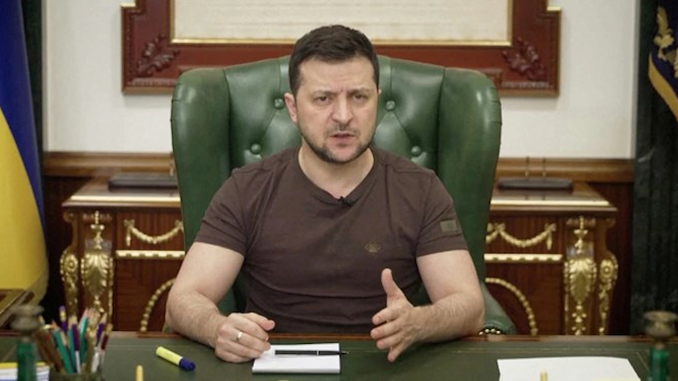
By Paul Angel
As I write this, the war in Ukraine rages on with scenes of destruction across the nation. It’s hard not to feel depressed when you see media depictions of once-gorgeous structures in Ukrainian cities being reduced to rubble and dead bodies in the streets. But we must get past these scenes to think rationally about the situation. The first thing to remember is that nearly everything you are hearing and seeing from both sides about the war is propaganda designed to manipulate you.
On one side, we hear that Russian President Vladimir Putin has sprouted horns and transmogrified into the Beast of the Apocalypse eager to unleash 21st-century nuclear devastation on the world. Ukrainian President Volodymyr Zelensky is a herald angel come from on high to deliver his people from the darkness.
Tall tales abound of old Ukrainian women throwing pickle jars at Russian soldiers and cursing them, civilian pilots shooting down dozens of Russian fighter jets, Russian conscripts surrendering in droves, and the evil Putin—a modern-day Ivan “the Terrible”—personally ordering missile strikes on maternity wards and nuclear power plants.
Some of the “just-released” film footage presented on the internet of the war, not surprisingly, has turned out to be clips from a decade ago. Other video is all-too real, showing injured Ukrainian civilians wounded in Russian bombardments.
On the other side we hear that Vladimir Putin is the second coming of the Christian tzars, ready to recapture not only the glory of the old Russian Empire, but the territory of the former Soviet Union.
It is the Ukrainian people, Putin says, who have been poisoned—“neo-Nazified” and enslaved by worthless drug addicts under the tutelage of the woke West. Putin, they say, had good reason to invade Ukraine, one being that there were, it appears, mass murders of ethnic Russians in the Donbass region carried out by Ukrainian-backed militias and soldiers, not to mention ominous U.S.-run biolabs strewn across the country. The West has steadily encroached on Russia for decades, goading Russia into this great defensive war, Russian media insist.
So, what news is true and what news is not? Very little of it, but that is to be expected in times of war. It’s certainly nothing new. Just take a brief look at history.
Exaggerated media tales of Mexican depredations against Texans and the portrayal of Mexicans as backward and “dangerous rapists and papists” helped those fomenting war unify public opinion against Mexico. On the other side, the Mexican media and government propagandists riled up the public with the account of a 13-year-old boy who died helping to defend Mexico City.
Dishonest reporters in the Far East, looking to earn their keep, made up an incendiary story, posted it for publication and were responsible for starting the Boxer Rebellion.
Fantastic fictional media tales—eagerly repeated by U.S. politicians—of Spanish atrocities against the people of Cuba helped the U.S. government convince the citizenry to support the Spanish-American War—but only after the news media enthusiastically parroted the unverified story that Spanish terrorists had blown up the Maine.
To help sway people to support World War I, the U.S. and foreign press circulated fake news stories about invading troops of the “Killer Kaiser” hoisting Belgian babies into the air and catching them on their bayonets while German soldiers were raping the mothers.
To justify America’s entry into World War II, many honest historians, including Adm. Tom Kimmel, believe the United States goaded Japan into attacking Pearl Harbor and that the assault on the Pacific naval base was no surprise at all to FDR. (We had a lot more than fear itself to fear then, including the pro-war media.)
Then there was the Gulf of Tonkin incident, where U.S. naval destroyers made purposefully provocative moves toward North Vietnamese shore batteries and succeeded in getting the Vietnamese to fire upon their vessels, thus providing an impetus for the disastrous U.S. intervention in Southeast Asia.
And who can forget the non-existent “weapons of mass destruction” that ended up being the reason for America’s mal-adventure in Iraq that cost the lives of not only thousands of Americans but a million innocent Iraqi civilians, as well.
All along the way—for every war and every foreign escapade—the U.S. news media was right there spouting whatever war propaganda they were told to. It is no different today.
But not all of it is lies. People are dying in Ukraine. But if we are going to go to war, let’s make sure we go for the right reasons. And, frankly, there are very few good reasons to go to war, certainly not in a nation that is not on our doorstep. In my opinion, this is Europe’s fight, not ours.
Haven’t we seen enough U.S. foreign policy failures to doubt whether an intervention in Ukraine would turn out any better than those in Iraq, or Syria or Afghanistan? Why would this be any different? It could be worse, as we would be tangling with a nuclear power. It’s madness.
On Jan. 25, 1898, William Randolph Hearst infamously said, “You furnish the pictures and I’ll furnish the war.” He was right. Photos of injured women and children pull at your heart strings, but we must resist this visceral response and think of the consequences. Non-intervention in the affairs of foreign nations is the only rational course for America in the past, the present and the future. We have to remember that, despite all the tragic photographs and the emotional hype from war-hawk politicians and their lemmings in the media.





